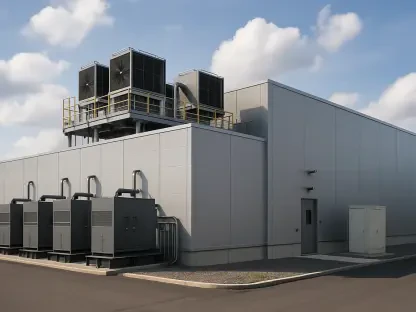The electric vehicle (EV) industry has been undergoing a significant transformation, driven in part by advancements in cloud computing and software integration. While the focus on AI might have somewhat overshadowed developments in this sector, the infusion of cloud technologies is catalyzing a shift towards more intelligent, connected, and efficient vehicles. This article delves into how cloud innovations are shaping the EV industry, exploring both the triumphs and challenges along the way.
The Evolution of the EV Industry
Market Penetration and Growth Trends
The EV market is growing at an impressive rate, albeit unevenly across different regions. The International Energy Agency (IEA) reported global sales of 14 million EVs in 2023, with China leading the charge. New Energy Vehicles (NEVs), which include options like fuel cells, form a significant part of this growth, accounting for 35% of new vehicle sales in China. However, outside key markets such as the US, Europe, and China, EV adoption remains slow. High purchase costs and a lack of supporting infrastructure continue to be significant barriers. A deeper look reveals that different regions exhibit varying levels of market maturity, with Europe and the US also making strides, albeit at a slower pace than China.
Despite global sales making up 18% of the total vehicle sales of 76 million in 2023, many countries lag behind due to economic and infrastructure limitations. These disparities necessitate localized strategies to boost adoption rates. An increased commitment to building charging networks and providing incentives can help reduce the gaps in adoption across different regions. Moreover, government policies and incentives, such as tax breaks, rebates, and direct subsidies, play a crucial role in promoting EV purchases. Public-private partnerships are also emerging as a viable model to expedite infrastructure development, making it easier for consumers to switch to electric vehicles.
Factors Driving Adoption
Government policies and incentives are pivotal in promoting EV purchases. Offering tax breaks, rebates, and direct subsidies are common strategies that governments employ to encourage consumers to switch to electric vehicles. Public perception of EVs also plays a significant role, with an increasing number of consumers viewing them as a more sustainable and environmentally friendly option. This growing sentiment among consumers further fuels the market by creating a demand for cleaner transportation alternatives. Infrastructure development is another critical factor in driving adoption rates.
Countries investing heavily in building efficient charging networks are witnessing higher market penetration rates. A robust and accessible charging infrastructure alleviates range anxiety among potential buyers, making electric vehicles a more viable option for everyday use. Public-private partnerships are also proving effective in accelerating the development of critical EV infrastructure. These collaborations bring together the resources and expertise of both the public and private sectors, facilitating quicker and more extensive rollouts of charging stations and other essential facilities.
Technological Integration and Cloud Platforms
Cloud-Native Architectures
Cloud-native platforms are revolutionizing how software is integrated into EVs. Leveraging technologies such as Containerd, Kubernetes, KubeEdge, and AI cloud-edge collaboration, companies like Huawei and NIO are pushing the envelope in vehicular intelligence. These cloud solutions streamline various aspects of vehicle software, making it feasible to deploy updates and new features more rapidly. Central computing units in vehicles manage multiple functions, from cockpit environments to intelligent driving systems. This transition towards software-defined vehicles allows for enhanced connectivity and smarter features.
Vehicle-to-Everything (V2X) communication is one such innovation, allowing cars to communicate with each other and infrastructure for improved safety and efficiency. The shift towards a cloud-native architecture also facilitates the integration of AI and machine learning algorithms, enabling vehicles to learn and adapt to different driving conditions and user preferences. This continuous learning capability enhances the overall user experience and safety features of electric vehicles, making them more appealing to consumers. Furthermore, the use of container technologies ensures that software updates can be deployed seamlessly, reducing downtime and improving the reliability of the vehicle’s systems.
The Role of Software-Centric Approaches
A software-centric approach is becoming the norm in the EV industry. Unlike traditional models that focused primarily on hardware, today’s vehicles integrate multiple software systems into a cohesive unit. This methodology facilitates real-time updates, feature enhancements, and smarter operations, encapsulating the concept of a “smarter car.” However, maintaining software consistency and optimal data utilization between simulated and real-world environments presents significant challenges. This makes comprehensive testing crucial, as software hiccups can lead to real-world issues, necessitating robust validation processes to ensure reliability.
Efforts to achieve software consistency are often hampered by the complexities involved in integrating various systems. This complexity underscores the need for sophisticated testing environments that can mimic real-world conditions as closely as possible. Effective data utilization is also critical, as the ability to analyze and act upon large volumes of data in real time can significantly enhance the performance and safety of electric vehicles. The adoption of agile development methodologies enables more rapid iterations and improvements, further pushing the boundaries of vehicular intelligence.
Challenges and Environmental Implications
Accelerated Vehicle Obsolescence
With the rapid pace of software updates, EVs face the challenge of becoming obsolete much faster than their traditional counterparts. This situation is akin to the lifecycle of consumer electronics such as smartphones and laptops. As new features and updates are rolled out frequently, older models may no longer support these advancements, pushing them prematurely towards obsolescence. This trend has significant environmental implications, as accelerated obsolescence increases the need for recycling and disposal of EV components, particularly batteries.
Ensuring sustainable recycling practices becomes crucial to mitigate the environmental impact, balancing innovation with ecological responsibility. The accelerated turnover of vehicle technology necessitates more frequent recycling, which could potentially overwhelm existing recycling infrastructures. New strategies and technologies for more efficient recycling processes are essential to keep pace with the increasing volume of discarded materials. The industry must also consider the lifecycle of materials used in manufacturing EV components, from mining to disposal, to develop more sustainable practices.
Infrastructure and Market Dynamics
The development and maintenance costs of cloud infrastructure pose another challenge. While these platforms enable faster and more efficient innovation, they require substantial investment. From navigation systems to networking features and driving assistance, the integration of cloud services into vehicles necessitates cross-collaboration between different domains. The automotive industry is therefore shifting from traditional V-shaped development models to hybrid approaches incorporating agile methodologies. This transition helps in managing the complexities of integrating cloud and software solutions, making development processes more adaptable and responsive to changes.
The shift to a hybrid development model allows for more flexible and iterative processes, facilitating quicker adaptations to new technologies and market demands. However, the costs associated with building and maintaining this cloud infrastructure cannot be overlooked. These costs often extend beyond the initial setup, encompassing ongoing maintenance and updates that ensure the systems remain functional and secure. Addressing these challenges requires a coordinated effort between automakers, tech companies, and regulatory bodies to develop sustainable business models that support the continued growth and evolution of the EV industry.
Sustainability and Digital Transformation
Balancing Progress and Environmental Responsibility
The EV industry stands at the intersection of digital transformation and sustainability. Cloud computing is a key enabler of this progress, driving rapid innovations and facilitating the development of advanced vehicular intelligence. However, the ensuing acceleration of technological cycles brings up concerns around sustainability. To address these issues, the industry must consider the ecological footprint of its innovations. From the production of high-tech components to the disposal of outdated parts, every stage of the lifecycle must be scrutinized to minimize environmental impact.
This balanced approach is essential for the long-term viability of both the technology and the environment. Sustainable practices can be implemented without compromising technological advancement by adopting more eco-friendly materials, improving recycling processes, and minimizing waste. Additionally, increased transparency and accountability in reporting environmental impacts can help to build consumer trust and drive more sustainable practices within the industry. As cloud innovations continue to reshape the EV industry, striking a balance between rapid technological advancement and environmental responsibility remains paramount.
Market Adaptation and Future Perspectives
The electric vehicle (EV) industry is experiencing a remarkable transformation, significantly driven by advancements in cloud computing and the integration of sophisticated software. While much attention has been devoted to artificial intelligence, it’s essential to recognize how cloud technologies are influencing the EV sector. These innovations are not only fostering the development of smarter, more connected vehicles but also boosting overall efficiency. Through enhanced data collection and real-time analytics, cloud computing enables better battery management, predictive maintenance, and improved vehicle-to-grid integration. Furthermore, over-the-air updates facilitated by the cloud are continuously enhancing vehicle performance without the need for physical interventions.
However, this rapid integration of cloud technology in EVs also presents challenges. Security concerns arise as vehicles become more connected, making them potential targets for cyberattacks. Additionally, the ongoing need for robust and reliable cloud infrastructure necessitates constant innovation. This article explores the multifaceted impact of cloud innovations on the EV industry, highlighting both the progress being made and the obstacles that lie ahead.









